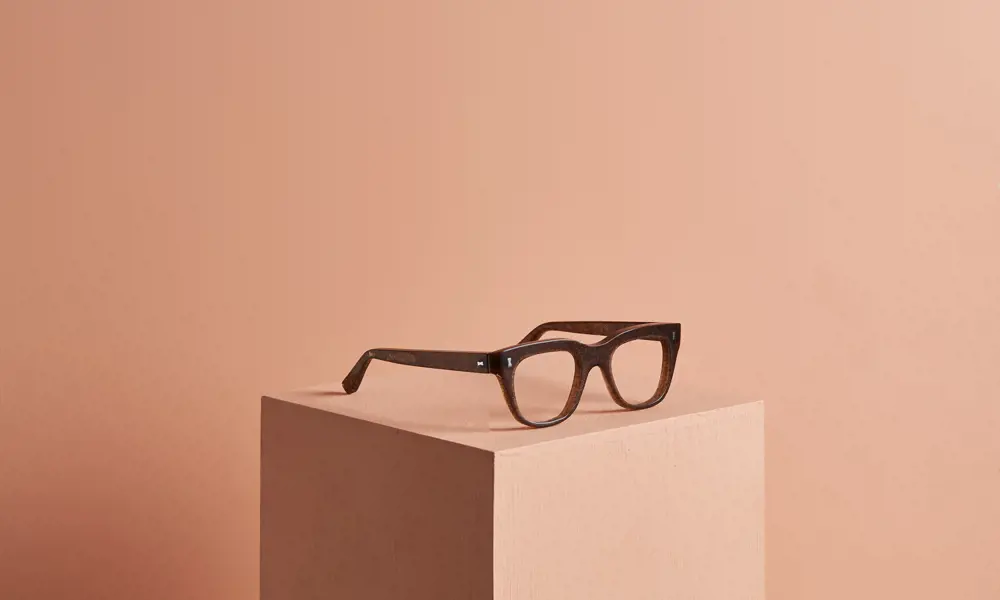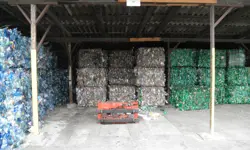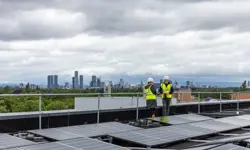
From food waste to fashion
In his previous role as a chef, Chip[s] Board Co-Founder Rowan Minkley noticed the abundance of food waste in the industry. He had studied design at university and so began developing prototypes made from food waste with a housemate, hoping to create sustainable materials for use in design. Knowing that one-third of all food produced becomes waste, Rowan and Co-Founder Rob Nicoll aimed to find value in it and create a true circular economy bioplastic. They discovered that they could make materials from food waste that were easily disposable as well as more durable.
Initially, the pair began by making an MDF substitute from potato waste, but soon discovered that they could make bioplastic materials from industrial food waste. They decided that this route would make more impact as a lot more can be achieved with a small amount of plastic compared to the large quantities needed for MDF.
Chip[s] Board has developed a process that transforms potato waste, supplied by McCain, into Parblex: plastic from potato waste. The bioplastic is made from the raw materials before fibre fillers, such as walnut shells and wood flour, are added to strengthen the plastic and give it qualities such as colour and texture. In its simplest form, Chip[s] Board is converting sugars and starches from food waste into a biopolymer without the use of solvents or any toxic by products.
The bioplastic is made from the raw materials before fibre fillers, such as walnut shells and wood flour, are added to strengthen the plastic and give it qualities such as colour and texture.
One of the key challenges that the team faced was creating its own laboratory facility for the entire process, which is complex biochemistry involving fermentation, purification and then polymerisation. Ensuring that all these stages work together and are balanced to optimise each part of the process took some fine-tuning. However, building a lab allowed the team to make sure that each part of the process had a minimal environmental impact: reducing energy consumption, removing chemicals, recycling heat, energy or water between the processes. The team is hoping to move to a larger pilot facility in 2021, where these values will continue to play a key role.
Once manufactured, the bioplastic is sold as pellets, which can be injection moulded, heat formed into sheets, or spun into fibres for textiles. The bioplastics are mechanically and chemically recyclable, so can be reused as plastic, as well as broken down into organic matter in industrial composting.
Chip[s] Board won the Royal Academy of Engineering Enterprise Hub’s Launchpad Competition in 2018, and Rowan Minkley is an Enterprise Fellow. While some projects have been put on hold because of COVID-19, the team is hoping to expand into bio-based plasticisers, which will allow it to make the material more flexible. Now a team of eight, Chip[s] Board is currently producing samples and setting up a pilot production facility in Yorkshire in the next few months, aiming to start selling directly to the fashion industry later this year.
***
This article has been adapted from "Innovation Watch -From food waste to fashion ", which originally appeared in the print edition of Ingenia 86 (March 2021).
Keep up-to-date with Ingenia for free
SubscribeRelated content
Environment & sustainability

The extreme engineering behind life on an Antarctic station
Antarctica is one of the most challenging environments on the planet, but of enormous scientific importance to humanity. Technology and engineering is essential to enable the British Antarctic Survey's researchers to pursue their science effectively in this awe-inspiring landscape.

Recycling household waste
The percentage of waste recycled in the UK has risen rapidly over the past 20 years, thanks to breakthroughs in the way waste is processed. Find out about what happens to household waste and recent technological developments in the UK.

Upgrade existing buildings to reduce emissions
Much of the UK’s existing buildings predate modern energy standards. Patrick Bellew of Atelier Ten, a company that pioneered environmental innovations, suggests that a National Infrastructure Project is needed to tackle waste and inefficiency.

An appetite for oil
The Gobbler boat’s compact and lightweight dimensions coupled with complex oil-skimming technology provide a safer and more effective way of containing and cleaning up oil spills, both in harbour and at sea.
Other content from Ingenia
Quick read

- Environment & sustainability
- Opinion
A young engineer’s perspective on the good, the bad and the ugly of COP27

- Environment & sustainability
- Issue 95
How do we pay for net zero technologies?
Quick read

- Transport
- Mechanical
- How I got here
Electrifying trains and STEMAZING outreach

- Civil & structural
- Environment & sustainability
- Issue 95